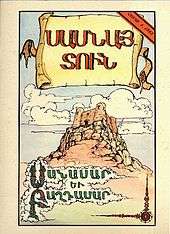Daredevils of Sassoun
Daredevils of Sassoun[1] (Armenian: Սասնա ծռեր Sasna cuṙer) is an Armenian heroic epic poem in four cycles (parts).
| Performance of the Armenian epic of 'Daredevils of Sassoun' or 'David of Sassoun' | |
|---|---|
 | |
| Country | Armenia |
| Domains | Performing arts (music) |
| Criteria | Oral literature |
| Reference | 743 |
| Region | Europe and North America |
| Inscription history | |
| Inscription | 2012 (7th session session) |
| List | Representative |
 | |
In the initial decades following the discovery of the epic in the late nineteenth century a general consensus emerged attributing its theme to the struggle of four generations of Sason's warriors against Muslim rule in the 8th to 10th centuries. The pioneers of this interpretation of the epic were the philologist Manuk Abeghian in Armenia and academic Joseph Orbeli at the Hermitage Museum in Leningrad, who argued that there are no characters in the epic that could be attributed to a historical person from before the 10th century.
The historicist school held its sway until the Armenian philologist Grigoryan first in an article (1981), then in a book (1989) argued following an incisive analysis of the epic, "it is indisputable that the roots of the epic go back deep into the centuries, and they reach not only the cuneiform times when monarchy was underway in Armenia, but even the prehistoric era." Grigoryan identified various episodes in the epic as of patently matriarchal origin, prompting various scholars both in Soviet Armenia and elsewhere to probe deeper into the proto-layers of the epic.
The Daredevils of Sassoun is commonly cited as one of the most important works of Armenian folklore. This recital of the legendary deeds of four generations of strongmen in a warrior community in the Armenian highlands is in the tradition of heroic folktales that dramatise the story of a whole nation and voice its deepest sentiments and aspirations, but unlike such well-known epics as the Iliad and the Odyssey (Homeric Greek), Epic of Gilgamesh (Sumerian), Beowulf (English), The Song of Roland (French), Cantar de mio Cid (Spanish) and others, it has survived solely by word of mouth, transmitted from one generation to another by village bards. The literary merits of the Sassoun saga surpass its value as a historical or linguistic document.
The performance of the Daredevils of Sassoun was included in the UNESCO Intangible cultural heritage representative list in 2012.[2]
Background

Սասնա (Sasna) translates to "belonging to Sassoun", in reference to Sasun – a region and a city located in Western Armenia in the rugged mountain country southwest of Lake Van – in what is currently Batman Province, eastern Turkey. Ծուռ (Tsour) literally translates to "crooked", traditionally connoting an animus of rebelliousness.
The most accurate and complete title of this epic is "Սասնա Ծռեր" (Rebels of Sasun). It has however been published under various titles such as "Սասունցի Դավիթ" (David of Sasun), "Սանասար և Բաղդասար" (Sanasar and Balthazar), "Սասունցի Դավիթ կամ Մհերի դուռ" (David of Sasun or Mher's door) and many others. All these titles correspond to one of four cycles of the epic.
The written literature of Armenia goes back to the fourth century CE , its Golden Age, when the Christian Bible was translated into the vernacular from the original Greek and Syriac texts. Plato and Aristotle were studied in Armenian schools and many original works of great interest to the modern specialist were produced by native historians, philosophers and poets.
While its oral literature is much older, recorded folk poetry has existed in Armenian for two thousand years. Movses Khorenatsi (Moses of Khoren) tells us in his classic "History of Armenia" (fifth century) that Armenians still loved the pagan "songs" the minstrels sang on festive occasions and often quotes from them. Only these fragments of pagan "songs" have survived to this day.
Songs celebrating memorable events have retained their hold in the popular imagination and it could be said that Armenians are a nation whose cultural identity has been formed from both the written and oral traditions, though little has survived of the latter due to its perishable nature and fluctuation of Armenia's historical borders.
Discovery of the story
The story of Sasun was "discovered" in 1873 by a bishop of the Armenian Apostolic Church, Garegin Srvandztiants, who had exceptionally close contacts with the peasantry in the more remote inaccessible parts of Western Armenia. He says:
For three years I tried to find somebody who knew the entire story, but nobody seemed to know all of it until I met Gurbo from a village on the Moush plain. I learned that his master had two pupils who also knew the tale by heart, singing verses in it, although Gurbo himself had not recited it for so long that he had forgotten a good deal of it. Nevertheless, I kept him with me for three days, I begged him, cajoled him, honored him, rewarded him, and when he felt better and was in the proper mood, he recited the tale for me in his own village dialect, and I wrote it all down in his own words.
The tale told by Gurbo was published in Constantinople (Istanbul) in 1874 under the title David of Sasun or Meherr's Door. The bishop wrote in the introduction:
The life of David and his exploits belong in the Middle Ages... The entire story is a record of courage, of domestic virtue, of piety, and of simple, open-hearted relations with his beloved woman as well as with his enemies. Despite its irregularities and anachronisms it has some fine stylistic qualities and narrative devices in it... The publication of this tale would be of interest to the understanding reader, but I suppose there will also be those who will express their contempt for it and abuse both the story and my own person. These readers will not understand it. But it does not matter. I shall consider myself encouraged if I find twenty sympathetic readers.
Language
Though the language abounds in poetic pictures, the physical sensory details are often missing. This is because an oral tale is necessarily different from that of a written story. The reciter would get on with his action and act out most parts of the story to hold interest of his audience, plot is the main thing, and the reciter suits the words of action. It's written in a beautifully controlled language and hyperbole is a characteristic device of this epic style.
Publications and translations

In 1881 "Daredevils of Sasun" was translated into Russian. Later the tale was translated into the languages of all fifteen republics of the Soviet Union. Next the text was translated into French and Chinese.
Other variants of this folk epic have been published since 1874, and there are some fifty of them altogether. Bishop Garegin Srvandztiants saved the Armenian epic from oblivion. 60 years later, Manuk Abeghian rendered an almost equally valuable service with his co-workers by collecting nearly all of these variants in three scholarly volumes published by the State Publishing House in Yerevan, Armenia in 1936, 1944 (part l) and 1951 (part ll), under the general title Daredevils of Sasun. All three volumes contain over 2,500 pages of text. In 1939 a collated text weaving most of the important episodes together was published for popular reading under the title "David of Sasun". As village texts are in various dialects, which presents many difficulties to the modern reader, the story was reworded and a fairly uniform style comprehensible to Eastern Armenian dialects was adopted. From 1939 until 1966 all translations were made from this popularized text. In 1964 Leon Zaven Surmelian, Armenian-American author, translated the epic into English from its original village stories under the name Daredevils of Sassoun.
See also
- Armenian literature
- Digenes Akritas
- National epic
- 2016 Yerevan hostage crisis; the hostage-takers referred to themselves as Sasna tsrrer
References
- Also known as Rebels of Sassoun.
- "Performance of the Armenian epic of 'Daredevils of Sassoun' or 'David of Sassoun'". UNESCO. 2012. Retrieved 27 November 2013.
Further reading
- Kouymjian, Dickran; Der Mugrdechian, Barlow (2013). David of Sassoun: Critical Studies on the Armenian Epic. Fresno, California: Press at California State University, Fresno. ISBN 9780912201450.
- Azat Yeghiazaryan, Daredevils of Sasun: Poetics of an Epic. Translated from Armenian by S. Peter Cowe. Costa Mesa, CA: Mazda Publishers, 2008
